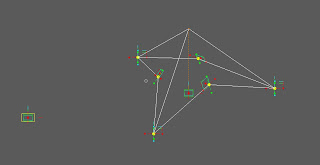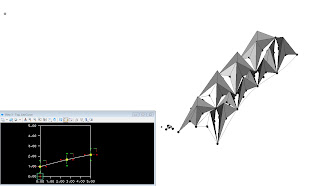I was able to spend a good portion of time today working with the Bentley Generative Components program and going through the tutorials. As was said in class, this software is so far ahead of anything that I have ever seen it is unbelievable. It is my new favorite software and I have very little idea how to use it. It combines written code with the digital modelling aspects of Microstation, best of both worlds. Plus I like the interface that it gives you including the easy 3D control and visualization in the modelling window. I haven't found the advantages of the simple graphical code view yet (the one similar to grasshopper) but I am sure that I just haven't come across its usefulness at this point. I also like the feature that allows you to view the entire transaction code in the transaction dialogue box, yet I can't follow the code (c#) quite well enough yet (just a matter of time). I can't even begin to imagine the capabilities of this program. I was working through trying to import point locations into Microstation from an excel file on my own time and finding that I needed to do a lot of research, but it seems if I use GC it should be easy. You even get an excel looking database interface when working in GC if you are using certain features. Plus there are lots of tutorials on this topic as it seems that GC was made with this in mind.
After going through the first 4 tutorials, I realize there is still a lot to learn and it will take a very long time to get used to it (probably years to master if that is even possible). Because of this, I feel like my capabilities in this program are currently limited, but I plan to try to see if I can create something on my own this weekend, at least as a trial (outside of tutorial help). I will however urge everyone in the class to block out a large portion of time if you want to go through the tutorials correctly and start to learn just the basics of the program; it really is that complex (but worth it in my opinion).
As a couple of tips, it is hard to keep remembering to save your transactions but it is a very important step. Also, remembering to hold ctrl down when selecting points (or objects) as input into functions is important. It also helps to keep a running list of your point and variable names, GC does this for you but it is difficult to access and figure out which point is which when you are in the script editor (you can choose a point but I was finding that I would forget which one to choose, and I couldn't select it in the model window with script editor open). Furthermore, explore Bentley's online help documents in their communities website. There is a lot of good help there. With that said, it is hard to find and navigate through their website. I would have never guessed that a company that can create such amazing software had what seems to be some trouble creating an easily navigable website. After searching for some time you will find that they have very helpful information on there website though, such as this link providing a good source of written information from Bentley about some of the basic features in GC:
Take a look at some of the images from my first
couple of attempts with the tutorials. The images don't even come close to showing the capabilities of the program but are interesting none-the-less.

















